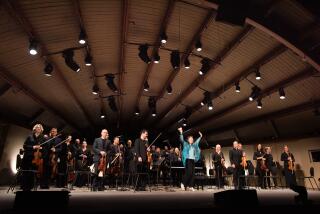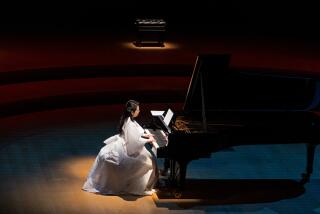Kipnis Plays Obscure Mozart in Fullerton
FULLERTON — It has been hoped that this Mozart year would bring with it a deeper understanding of the composer through performances of some of his rarer, less-appreciated works. Locally, these have been in very short supply.
Along comes harpsichordist Igor Kipnis, abandoning his accustomed instrument for the fortepiano and offering a mini-survey of Mozart’s keyboard music in Fullerton on Sunday. A deeper understanding? More like trivial pursuit.
Kipnis--opening the 33rd season of the Fullerton Friends of Music before a standing-room-only audience at Sunny Hills High School--went a little overboard in his search for Mozartean obscurities, in a program of musical footnotes.
He began with Mozart’s earliest known compositions, K. 1a and 1b, a very brief Andante and Allegro written when the composer was 5, following them with K. 1c-f, written later in the same year and early in the next, and K. 33B a short, untitled work written at the ripe old age of 10.
Then came the slightly more substantial Variations on “Mio caro Adone” (a Salieri tune), K. 173c; a Romance, until recently considered apocryphal by most--still is, maybe--reconstructed from a fragment by a modern scholar; an incomplete Fantasy, K. 383C, all 14 bars of it, and the “Kleiner Trauermarsch,” K. 453a. He closed the first half with a short Gigue, K. 574--composed in Leipzig, sounds like Bach--and another modern completion, this of the Allegro fragment, K. 590d.
All of this made the probably just-as-well-unmade point that Mozart wrote formulaic music when very young, solidly routine music when slightly older, and music that he deemed, for various reasons, not worth finishing all of his life.
Kipnis’ more substantive second half included the pensive Rondo, K. 511, the Sonata in A, K. 331, and two more fragments in encore. Throughout the concert he played with no special polish; small mistakes pretty much evenly dotted his performances. He offered graceful and singing lines consistently, however, and subtle shadings in the softer dynamic levels. His fortepiano, a copy of an 18th-Century Stein model, seemed better suited to a smaller hall--its expressive range (or Kipnis’) proved meager.
More to Read
The biggest entertainment stories
Get our big stories about Hollywood, film, television, music, arts, culture and more right in your inbox as soon as they publish.
You may occasionally receive promotional content from the Los Angeles Times.










